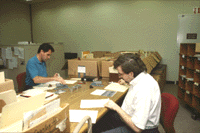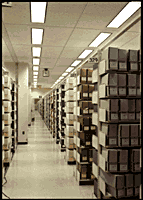



The Manuscript Division was one of several "departments" established in 1897 when the Library of Congress moved from its cramped quarters in the United States Capitol to its own magnificent new structure across the street. The division's first chief estimated that the size of his collections was twenty-five thousand items. Today, a century later, the Manuscript Division holds eleven thousand collections containing more than fifty million items. These collections document all aspects of American history and culture and include some of the nation's greatest manuscript treasures.
Mining the treasures of the Manuscript Division is a lifelong pursuit for researchers and staff alike. Longtime employees and seasoned scholars are constantly amazed by both the documented riches and the unexpected finds. The thrill of discovering the unknown, the excitement of handling famous documents, and the feeling of connecting with people and events of the past are among the most satisfying aspects of archival work. Through the Library's diverse collection of manuscripts, history comes alive, attaining an immediacy that is both unique and rewarding for anyone who ventures into the Manuscript Division's holdings.
Letters, diaries, and other documents--from both the recent and the distant past--speak of a nation's hopes, disappointments, and accomplishments. The style and modes of expression differ markedly, but whether eloquent or crude, these manuscripts transport the reader to a time and place that may be radically different from the present or, conversely, seem comfortingly familiar. By collecting, preserving, and making available for research use documents of the American past, the Manuscript Division promotes the pursuit of knowledge that is central to all great civilizations. Its staff is proud to serve as custodians of the nation's historical legacy and we invite you to learn more about the division's activities and holdings by visiting the various pages of this web site and others relating to the Manuscript Division.
What Does the Manuscript Division Hold?The Library of Congress Manuscript Division holds what is perhaps the most extensive and comprehensive collection of personal papers and organizational records relating to American history and culture ever assembled. Among the division's greatest treasures are Thomas Jefferson's rough draft of the Declaration of Independence, James Madison's notes on the Constitutional Convention, George Washington's first inaugural address, the paper tape of the first telegraphic message, Abraham Lincoln's Gettysburg Address and his second inaugural address, Alexander Graham Bell's first drawing of the telephone, and countless other items documenting similar dramatic events in our nation's history.
Foremost among the division's collections are the papers of twenty-three presidents of the United States ranging in time from George Washington to Calvin Coolidge. Also preserved are the papers of Cabinet ministers, members of the United States Senate and House of Representatives, Supreme Court justices and other members of the federal judiciary, military officers and diplomats, artists and writers, scientists and inventors, and other prominent Americans whose lives reflect our country's evolution. Joining the papers of individuals are the records of a number of nongovernmental organizations which have significantly shaped American society. Several of these are civil rights and economic assistance organizations such as the National Association for the Advancement of Colored People, National Urban League, National American Woman Suffrage Association, National Woman's Party, and Brotherhood of Sleeping Car Porters. Other large organizational collections include the records of the League of Women Voters and the American Colonization Society. Supplementing the division's original manuscript sources are microfilm copies of related collections in other American repositories as well as transcriptions, photostatic copies, and microfilm of manuscripts and archives related to American history that are located in foreign repositories.
The overwhelming majority of the division's collections comprise the personal papers of individuals and families. They differ from the holdings of the National Archives and Records Administration, which maintains the official records of the United States government. The most interesting of the Manuscript Division collections relate not only to individuals' professional or political careers but reflect their private lives, suggesting how their origins, family relationships, personal experiences, motivations, prejudices, and humor affected their public behavior and activities. As a record of the whole person, these collections contain many different types of manuscripts. Included are diaries, correspondence (both incoming and copies of outgoing letters), notebooks, accounts, logs, scrapbooks, press clippings, subject files, photographs, and other documents in every conceivable form--handwritten and typewritten, originals, carbons, letterpress copies, microfilm, and computer diskettes. When the poet Carl Sandburg wrote about the private Lincoln collection of Oliver Barrett, he could just as easily have been describing the papers in the Manuscript Division.
Many kinds of paper here--heavy parchment and vellum engrossed--legal cap--letter and note paper--scrap--newsprint of the later era now beginning to disintegrate--rag paper of the previous generation, tough and fibrous and good for centuries to come with its register of handwriting or printing--quiet paper that whispers its tender message, or groaning, roaring paper that for those of imagination carries its own grief or elation of a vanished hour and day. Paper, if you please, sir or madam, as soundless as hushed footfalls on silent snow.1

|
| John Adams's letter ordering the relocation of government offices from Philadelphia to the District of Columbia. United States Commissioners of the City of Washington Records, Manuscript Division |
Although interesting as artifacts, the real worth of the manuscripts in the Library of Congress lies in their evidentiary value. They are the primary sources upon which the writing of history is based. They permit scholars to reconstruct and understand the past, interpret the national character, and set the record straight about events and personalities often shrouded in mystery and steeped in controversy. The historical value of the Library's manuscripts is enhanced by their scope, size, and concentration in one place. A scholar planning initially to consult one collection will be drawn to a complementary collection containing documents which clarify, enhance, and contradict the first set of manuscripts. It is rare for patrons to leave the Manuscript Division without finding something relevant to their research. Moreover, the Library's manuscripts are housed in immediate proximity to the institution's unsurpassed collections of books, pamphlets, magazines, newspapers, maps, motion pictures, charts, prints, sound recordings, and photographs that can supplement the scholar's manuscript research.
How Does the Library of Congress Acquire Manuscripts?Manuscripts are normally acquired by the Library of Congress in one of three ways: purchase, gift, or copyright deposit. Many of the earliest acquisitions were purchased by the Library directly or transferred from other government agencies. The institution's first manuscript acquisitions, the Records of the Virginia Company of London, were included with the books, maps, and other items that the federal government purchased from Thomas Jefferson in 1815 and 1829 to replace the earlier congressional library burned by British troops during the War of 1812. In 1867 Congress appropriated $100,000 to purchase the Peter Force Papers, one of the nation's first great privately assembled manuscript collections. A year earlier, Dolley Madison's papers had been transferred from the Smithsonian Institution, and in 1903 President Theodore Roosevelt signed an executive order directing the transfer to the Manuscript Division of the State Department's historical archives. Roosevelt's action, one of the most significant in the division's history, brought to the Library the major corpus of the papers of George Washington, Thomas Jefferson, James Madison, and James Monroe, as well as large bodies of the papers of Benjamin Franklin and Alexander Hamilton. Funds established by private benefactors also permitted the Library to purchase manuscripts unobtainable within the budget appropriated by Congress, including the papers of poet Walt Whitman, artist James McNeill Whistler, and psychoanalyst Sigmund Freud, as well as copies of records in foreign repositories relating to American history.
Notwithstanding these notable purchases, most of the Manuscript Division's acquisitions in the twentieth century have been donated or, in the case of microfilm, acquired through copyright deposit. Many prominent Americans have accepted the division's invitation to donate their papers to the national library during their lifetimes. Other collections have been bequeathed or received as gifts from heirs. Only through the generosity of countless donors has the Manuscript Division amassed one of the world's finest collections of historical manuscripts. As such, our holdings are a testament to the patriotism of the American people, who have followed Thomas Jefferson's charge that it is "the duty of every good citizen to use all the opportunities, which occur to him, for preserving documents relating to the history of our country."2
How Does the Staff Prepare a Collection for Research Use?

|
| Archivist Harry Heiss and archives technician Scott McLemee processing the Victor Gruen Papers. Manuscript Division Slide Collection |
The ease with which a collection is organized depends upon the condition and order of the manuscripts upon receipt. Many present-day archivists can appreciate former President James Madison's despair that the "tedious" arrangement of his papers was absorbing more of his time than anticipated, interfering, he added, with the enjoyment of his retirement.3 During the third winter that her husband devoted to his manuscripts, Dolley Madison restlessly noted that "the business seems to accumulate as he proceeds, so that it might outlast my patience, and yet I cannot press him to forsake a duty so important, or find it in my heart to leave him during its fulfillment."4 Careful arrangement and accurate description are indeed time-consuming and important tasks. Both contribute to a collection's preservation, security, and accessibility for research use.
To facilitate access to a collection, an archivist usually prepares a register or finding aid. This document generally is divided into several parts. The first part includes information about the collection's provenance (or source) and the conditions under which it may be accessed, reproduced, or quoted. The biographical note or organizational history lists the important dates and events in the life of the individual or organization featured in the collection. The scope and content note describes the arrangement of the collection, the topics covered, and any notable gaps or weaknesses in the collection. The series description outlines the major groups or series of papers, and the container list identifies in progressive detail the contents of the papers together with the corresponding call numbers, container numbers, or other means for researchers to identify and request the material of interest to them.Also prepared is a catalog record which summarizes the finding aid and identifies key search terms, such as personal and corporate names and subjects represented in the collection. Catalog records for all of the division's collections are searchable on the Library's main catalog, which is accessible worldwide through the Internet. The manuscript catalog records are also distributed to other national databases.

|
| Manuscript Division stacks with acid-free containers. Manuscript Division Slide Collection |
Organized collections are stored in acid-free folders within similarly treated containers to retard deterioration. Damaged items are repaired and restored by talented and knowledgeable specialists in the Library's state-of-the-art conservation facilities. The collections, in their acid-free containers, are then shelved in secure, fireproof stacks with temperature and humidity controls. Currently, the Manuscript Division occupies 13 miles of shelving space in the Library's James Madison Memorial Building and another 5.6 miles in an offsite storage facility.

|
| Manuscript Division Reading Room. Manuscript Division Slide Collection |
1. Carl Sandburg, Lincoln Collector: The Story of Oliver R. Barrett's Great Private Collection (New York: Harcourt, Brace and Company, 1949), 4.
2. Thomas Jefferson to Hugh P. Taylor, 4 October 1823, Thomas Jefferson Papers, Manuscript Division, Library of Congress.
3. James Madison to John G. Jackson, 27 December 1821, James Madison Papers, Manuscript Division, Library of Congress.
4. Dolley Madison to Mrs. Andrew Stevenson, 1826, as quoted in Allen C. Clark, Life and Letters of Dolley Madison (Washington: W. F. Roberts Co., 1914), 223.
am Sep-8-97